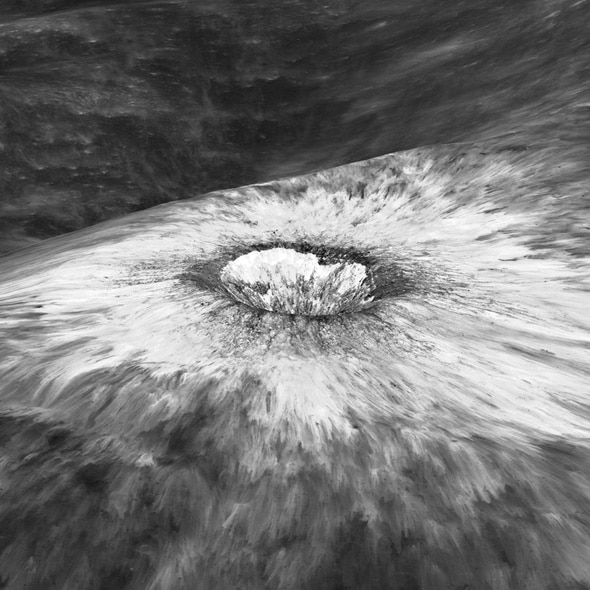Create a free profile to get unlimited access to exclusive videos, sweepstakes, and more!
The Delicate Petals of a 30 Megaton Impact

I’m not a geologist. I’m an astronomer, and a general science enthusiast, with an extra dollop of enthusiasm set in reserve for geology.
It’s one of the reasons I’m so enthralled with asteroid impacts. I get both astronomy and geology in one fell swoop (with a not-incidental soupçon of dinosaurs, too, for somewhat obvious reasons)!
But, since it’s not my field, I still get baffled when I see certain things. Happily, I have a bunch of geologist friends (scientists hang out in packs) to whom I can send questions. Other times, the answer is right in front of me.
The image above is from the Lunar Reconnaissance Orbiter Camera and shows a crater on the Moon nicknamed Chappy (it formed in the much larger Chaplygin crater). It’s about 1,400 meters across (a bit bigger than Barringer crater in Arizona), which means that whatever asteroid or comet slammed into the Moon here exploded with the yield of about a 30 megaton bomb—about as big as any nuke ever detonated by humans. The fresh pattern of ejected material around it suggests a very young age. How young is hard to know, maybe only a few millennia, maybe more. But over time micrometeorite impacts and the solar wind soften and fade those features, so the crater isn’t, say, millions of years old*.
The pattern around Chappy shows broad, wide streaks, seemingly overlapping with streaks of different contrast, looking very much like the petals of a flower.
It’s that lovely pattern that got me thinking. Sometimes craters have rays, thin, long, linear features that can extend for thousands of kilometers in bigger impacts. Rays are caused by plumes of material ejected from the impact event; the material blasts outward then settles onto the surface making the radial streaks.
When the Moon is full, the huge crater Tycho shows prominent rays, one of the more iconic features on the Moon. I’ve seen it and them hundreds of times through my own telescope, one of the few really interesting features visible when the Moon is full.
That biased me. I’ve written about craters that have these broader petal patterns before, ascribing to them the same formation mechanism as rays: collapsing plumes from the impact.
But that’s wrong. In the LROC blog post about the image, they give the correct mechanism: ground flow. Material blasted out from the impact flowed along the lunar surface, hugging the ground, moving up and down over the hummocky surroundings, and flowing around or deflected by obstacles. That also explains the shapes of the petals; the endpoint of each (the terminus) is where the material stopped flowing, either as momentum was lost due to friction or the material simply ran out. Some flows are thicker, some less dense, which can give them different brightnesses on the ground.
When I read that, I almost slapped my forehead. Of course those can’t be from plumes that traveled up and away; the shape is all wrong. But I was prejudiced from what I already knew, not thinking there could be other mechanisms at work.
I urge you to subscribe to the LROC images blog; they post truly beautiful and fascinating images taken by the camera, with a description written by someone familiar with the data. It’s a seemingly endless source of wonderful science.
P.S. At the bottom of their Chappy post is an interactive widget where you can scan, pan, and magnify the terrain around Chappy, and it’s incredible. Go.
* Update, Apr. 9, 2016: Or is it? I got a note from planetary scientist Clark Chapman about this, and he correctly pointed out that Tycho is probably 100 million years old and still has obvious rays, as I actually mention in the article. So having bright ejecta patterns is not necessarily the indicator of extreme youth I thought it was. Now I have to start looking into why Tycho's rays are still so bright after such a long time...














